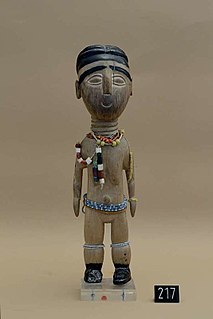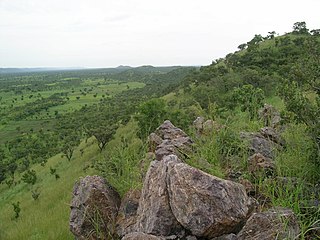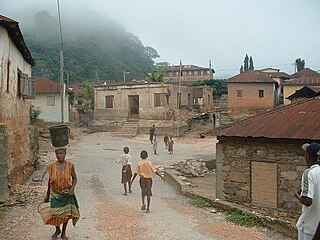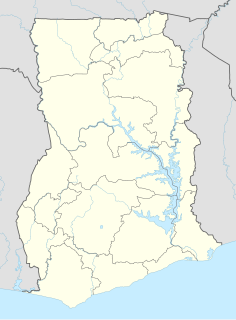
Togo, officially the Togolese Republic, is a country in West Africa. It is bordered by Ghana to the west, Benin to the east and Burkina Faso to the north. The country extends south to the Gulf of Guinea, where its capital and largest city Lomé is located. Togo covers 57,000 square kilometres, making it one of the smallest countries in Africa, with a population of approximately 8 million, as well as one of the narrowest countries in the world with a width of less than 115 km (71 mi) between Ghana and its eastern neighbor Benin, which is also quite narrow, except for its northern parts.

The demographics of Togo include ethnicity, population density, age, education level, health, economic status and religious affiliation.
The Dagombas are a Gur ethnic group of northern Ghana, numbering more than 2.3 million people. They inhabit the Northern Region of Ghana in the sparse savanna region below the sahelian belt, known as the Sudan. They speak the Dagbani language which belongs to the Mole-Dagbani sub-group of the Gur languages. There are around 1 to 2 million speakers of Dagbani. The Dagomba are historically related to the Mossi people. The Mohi/Mossi now have their homeland in central present-day Burkina Faso. The homeland of the Dagomba is called Dagbon and covers about 20,000 km2 in area.

The Lossos are an ethnic and linguistic group of people living in the Doufelgou District (Préfecture) of the Kara Region in Northern Togo, West Africa. The district capital is Niamtougou which is also an important regional market town. The Lossos live on a plateau in the Togo Mountains between two mountain ranges: the Kabiyé Mountains to the South and the Défalé Chain to the North. They occupy the communities of Niamtougou, Koka, Baga, Ténéga, Siou, Djogrergou, Sioudouga, Kpadeba, Hago, Koukou, and Kounfaga. The Doufelgou District is bordered by the Kozah District to the South, by the Binah District to the East, by the Bassar District to the West, by the Kéran District to the North, and by the international border with Bénin to the Northeast.

The Ewe people are a Gbe ethnic group. The largest population of Ewe people is in Ghana, and the second largest population in Togo. They speak the Ewe language which belongs to the Gbe family of languages. They are related to other speakers of Gbe languages such as the Fon, Gen, Phla Phera, and the Aja people of Togo and Benin.

Centrale is one of Togo's five regions. Sokodé is the regional capital. Centrale is the least populated region in Togo with a total of 617,871 people according to a census done in 2010.

The Greater Accra Region has the smallest area of Ghana's 16 administrative regions, occupying a total land surface of 3,245 square kilometres. This is 1.4 per cent of the total land area of Ghana. It is the second most populated region, before the Ashanti Region, with a population of 5,455,692 in 2021, accounting for 17.7 per cent of Ghana's total population.
The Ga-Dangbe, Gã-Daŋbɛ, Ga-Dangme, or GaDangme are an ethnic group in Ghana, Togo and Benin. The Ga and Dangbe people are grouped respectively as part of the Ga–Dangme ethnolinguistic group. The Ga-Dangmes are one ethnic group that lives primarily in the Greater Accra of Ghana. Ethnic Ga family names (surnames) such as Nikoi, Amon, Kotey, Kotie, Adei, Kutorkor, Oblitey, Lartey, Nortey, Aryee, Poku and Lamptey. The following are names derived from the ethnic Dangme and common among the Ningos Nartey, Tetteh, Kwei, Kweinor, Kwetey, Narteh, Narh, Dugbatey, Teye, Martey, Addo, Siaw, Saki, Amanor, Djangba. These are aligned to the ethnic Ga as well: Lomotey, Tetteh, Ankrah, Tetteyfio, Laryea, Ayitey, Okai, Bortey, Quaye, Quaynor, Ashong, Kotei, Sowah, Odoi, Ablor, Adjetey, Dodoo, Darku and Quartey.
The Tabom People or Agudas are the Afro-Brazilian community in the South of Ghana who are mostly of Yoruba descent. The Tabom People are an Afro-Brazilian community of former slave returnees. When they arrived in Jamestown, Accra they could speak only Portuguese, and would conspicuously use the phrase “Tá bom” (“Okay”), so the Ga-Adangbe people who primarily inhabited the Jamestown neighborhood in Accra, South Ghana started to call them the Tabom.

Ghana is a multilingual country in which about eighty languages are spoken. Of these, English, which was inherited from the colonial era, is the official language and lingua franca. Of the languages indigenous to Ghana, Akan is the most widely spoken.
Bissa, is a Mande ethnic group of south-central Burkina Faso, northeastern Ghana, the northernmost tip of Togo and northern Benin. Their language, Bissa, is a Mande language that is related to, but not the same as, a cluster of languages in the old Borgu Kingdom area of Northeast Benin and Northwest Nigeria, including Busa, Boko, and Kyenga. An alternate name for the Bissa is Busansi which is used by the Mossi people.

The Togo Mountains is a mountain range which stretches across the central region of the West African country of Togo and across the eastern and western borders of that country into Ghana and Benin. In Ghana, the range is also known as the Akwapim Hills, and in Benin it is also known as the Atakora Mountains. Part of the range is associated with the country of Niger, where the W National Park is found. The African wild dog, Lycaon pictus, was historically found in this region but may now be extirpated from this locale.

The Logba people live in the Volta Region of Ghana, east of the Volta Lake in the mountains of the Ghana-Togo borderland. Most Logba towns and villages are situated along the trunk road from Accra to Hohoe. They include the following settlements: Wuinta, Akusame, Adiveme, Andokɔfe, Adzakoe, Alakpeti, Klikpo, and Tota. Tota is located high in the Ghana Togo Mountains to the east of the Accra-Hohoe road. Alakpeti is the commercial centre of Logba, while Klikpo is traditionally the seat of the head of the Logba people. The Logba people are primarily subsistence farmers, producing cassava, maize, yams and forest fruits, supplemented by cash crops like cocoa, coffee and sawn mahogany logs. The Logba area is known for its scenery, which includes waterfalls, cliffs, and limestone formations, including one or two known small caves with minor speleothems.
The Chamba people are a significant ethnic group in the north eastern Nigeria. The Chamba are located between present day Nigeria and Cameroon. The closest Chamba neighbours are the Mumuye, the Jukun and Kutep people. In Cameroon, the successors of Leko and chamba speakers are divided into several states: Bali Nyonga, Bali Kumbat, Bali-Gham, Bali-Gangsin, and Bali-Gashu. The are two ethnic groups in Ghana and Togo also called Chamba, but they are ethnically distinct. The Chamba are identified through their own language, beliefs, culture, and art.
Mamprusis are an ethnic group in northern Ghana and Togo. Estimates are that there are about 200,000 Mamprusis living in the Northern Regions of Ghana as of 2013, They speak Mampruli, one of the Gur languages. In Ghana, the Mamprusis live mainly in Nalerigu, Gambaga, Walewale, and their surrounding towns and villages in the North East Region. Their origin is in the Upper East Region, principally, Bawku, and they also inhabit parts of the Upper West Region, too.

Big Ada is a town in the Ada East District, a district in the Greater Accra Region of Ghana. The settlement lies along the road from Ada Kasseh to the district capital Ada Foah, just off the Accra-Aflao motorway.
Abofour is a town in the Offinso Municipality in Ashanti Region of Ghana It is the second largest town in the Municipality after the Offinso township. It is in fact one of the most populated townships in the Ashanti REGION of Ghana. Though Offinso is the Municipal capital, Abofour undoubtedly is the ecomic hub of the municipality by the virtue of having one of the largest Markets in the country.
The Anii or Basila language is spoken in Benin, and central eastern Togo and central eastern Ghana. It is part of the geographic group of Ghana Togo Mountain languages of the Kwa branch of Niger–Congo.

The Avenor Ewe are a sub-tribe of the Ewe people of Ghana. The origin of the name Avenor is not known.

The Kingdom of Dagbon is one of the oldest and most organised traditional kingdoms in Ghana founded by the Dagomba people (Dagbamba) in the 11th century. During its rise, it comprised, at various points, the Northern, Upper West, Upper East and North East regions of present-day Ghana. Since Ghana's independence in 1957, the Kingdom just like all of Ghana's kingdoms and ethnic states has assumed a traditional, customary role.












